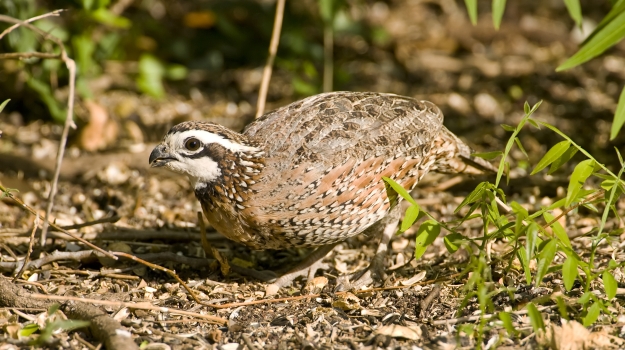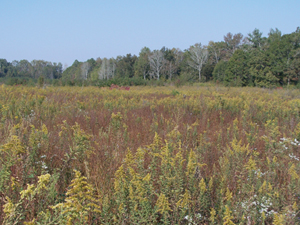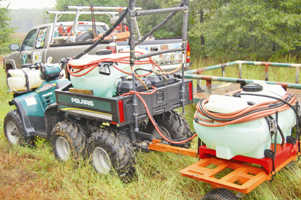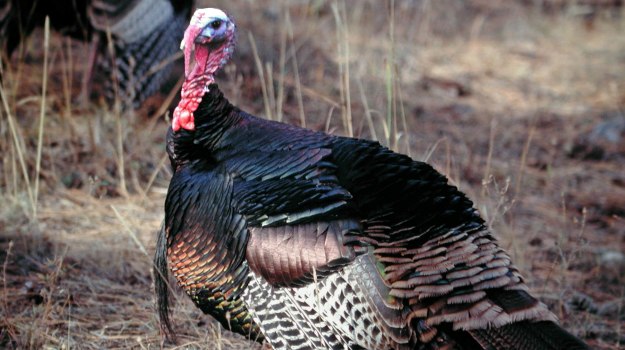
Mark W. Thomas | Certified Wildlife Biologist/Forester
During the last 45 years, northern bobwhite quail populations in the Southern United States have plummeted. From 1966 to 1995, quail populations in Mississippi, Alabama, Georgia, and Florida declined annually by 3.5%, 3.7%, 3.9% and 2.7%, respectively. The decline accelerated from 1980 to 1995, with average annual declines of 4.4%, 6.3%, 4.6% and 4.7% for those states, respectively. The annual decline across the United States averaged 2.4% from 1966 to 1995 with an increase in the average decline to 3.0% for the years 1980 to 1995. In Alabama, the decline almost doubled, from an average of 3.6% annually to 6.3% annually.
Reasons for the decline are many and include this prioritized list in order of impact; agricultural grain crop/marginal cropland conversion to fescue, low-quality hardwood understory invasion in forestland, non-native plant species displacement of native plant communities, mortality induced by fire ants, inappropriate use of prescribed fire and mechanical treatments, and predation. Habitat changes seem to account for the majority of the declines.
 At the Black Prairie Research Area of west central Mississippi, the utilization of five cultural treatments has led to a dramatic increase in native wild quail populations. The native quail population increased form 18 coveys to 235 coveys in three covey seasons, an increase of over 13-fold, and finally stabilized at 185 coveys. The five cultural treatments listed in priority with respect to impact are; imazapyr (Arsenal®) for non-native plant eradication and low-quality hardwood brush control, imazapic (Plateau®) for native warm season grass enhancement, hydramethylnon (Amdro®) for fire ant control, rotational strip discing, and rotational prescribed burning.
At the Black Prairie Research Area of west central Mississippi, the utilization of five cultural treatments has led to a dramatic increase in native wild quail populations. The native quail population increased form 18 coveys to 235 coveys in three covey seasons, an increase of over 13-fold, and finally stabilized at 185 coveys. The five cultural treatments listed in priority with respect to impact are; imazapyr (Arsenal®) for non-native plant eradication and low-quality hardwood brush control, imazapic (Plateau®) for native warm season grass enhancement, hydramethylnon (Amdro®) for fire ant control, rotational strip discing, and rotational prescribed burning.
Imazapyr, one of the imidazolinone herbicides, was introduced to forest managers in 1986 and has become the dominant herbicide used for silvicultural applications in the South. Uses include site preparation, herbaceous weed control, conifer release, mid- and late-rotation release, improving forest aesthetics, and wildlife habitat enhancement. It is especially well suited for bobwhite quail habitat management as legumes (lespedeza, partridge pea, beggarweeds, etc.) and rubus species (blackberry and dewberry) are tolerant and recolonize areas after treatment, as they are released.
Other plant species that recolonize treated sites can include ragweed, goldenrod, pokeweed, fireweed, milkweed, panicum grasses, and other early pioneer successional species. In areas dominated by mature longleaf and loblolly pine where low-quality hardwood brush has been controlled by imazapyr followed by a prescribed burn, native quail populations have increased up to ten-fold in the last six years. An increase in forbs, legumes and rubus species occurred. Average seed weight in legumes has been documented, as well as an increase in the protein content of seeds. Due to an increase in flowering plants, insects have been shown to be more abundant for several years following applications for much of the entire growing season. The reduction in low-quality hardwoods in the understory followed by a prescribed burn has resulted in up to 33-fold increases in forbs (dry weight basis).
Mechanical treatments have long been used as bobwhite quail habitat management tools, especially roll drum chopping and brush hogging. Neither treatment adequately controls hardwood rootstocks and actually increases the number of low-quality hardwood stems due to prolific sprouting. Research shows that each rootstock will send up an average of 9.2 sprouts. A new mechanical device, called a Maddron drag, when used in combination with an imazapyr application, has been recently tested. Maddron drags consist of old crawler tractor tracts. Advantages noted include nearly permanent hardwood control, exposure of bare mineral soil, and the recolonization of legumes, rubus species, flowering plants and forbs. The treatment smoothes out the soil and allows for easier walking for hunters and can be less expensive and more productive than other mechanical methods.
A new tool, called the Brush Master® square-wheel disc, has also been tested. This disc has flex risers that support the axles and triple sealed bearings. The flex risers absorb the shock and this disc can be utilized in very tough conditions, including in the woods. You can pull it directly over stumps without damage. Coming in three sizes, the smallest unit is 7’3” and weighs just over 2,200 pounds. I use this unit for rotational strip discing in forested and non-forested.
Bobwhite quail toxicology testing has also been conducted on imazapyr. Oral LD50 values of >2,150 mg/kg body weight and eight day dietary LC50 values of > 5,000 ppm were determined. In 18-week toxicity and reproduction studies, no treatment-related signs of systemic toxicity and no adverse effects upon reproductive performance and egg production, egg thickness, egg quality and hatchability were found at dietary levels of up to 2,000 ppm, the highest dose tested. No mutagenic effects, teratogenic effects or fetotoxic effects were observed. Environmental fate studies have also been conducted. The calculated half-life of imazapyr in forest soil ranged from 19 to 34 days. Half-life of imazapyr in plant and pine tissue ranged from 12 to 40 days. Half-life in leaf litter ranged from 37 to 44 days.
Low-quality understory hardwood control and other uses of imazapyr for bobwhite quail habitat management enhances preferred food plants, increases access for wildlife management activities, enhances hunter visibility and safety, improves forest aesthetics, increases wood production, and increases early successional plant biodiversity, reduces the accumulation of fuel and reduces the intensity and frequency of prescribed fire, which, together, dramatically increase the carrying capacity, and subsequent population, of bobwhite quail.
 Work at the Wheeler Estate/Wheeler Foundation lands (Lawrence County,
Work at the Wheeler Estate/Wheeler Foundation lands (Lawrence County,
Alabama) from 2004 to 2007 treated approximately 2,000 acres for northern bobwhite quail habitat improvement, or approximately 500 acres per year. Quail habitat was lost due to batwing bushhog treatments, and the areas were in danger of losing CRP status. Low-quality sweetgum averaged from 5,000 to 10,000 stems/acre, with virtually no herbaceous component. Equipment for foliar applications included Polaris 6X6 rigs with 50-gallon capacity on the back and 25-gallon tanks on the front, coupled with 50-gallon pup trailer, allowing for around 12.5 acres/load @ 10 GPA. Production averaged around 50 acres per day. Rates utilized ranged from 16 to 20 oz/ac and tankmixes with Escort® and Roundup Pro® to control blackberry (rubus spp.) were used as needed. Each treated compartment was side trimmed and fire lanes were established around each, as well. Ecotones were then established utilizing straight imazapyr varying in width from 10 to 30’ wide. All light-seeded edge trees (sweetgum, box elder, ash, maple, etc) were then injected with imazapyr (50:50 V:V) during the late fall or in the dormant season. Prescribed burning was not utilized, and early successional plant communities (listed below) recolonized within a few months after the applications. Plants tolerant of imazapyr (legumes and rubus species) are also listed below.
Food Items Most Frequently Eaten From 1,400 Quail Crops Averaged Over 10 Years:
| Food Item | % Appeared |
| Trailing Wild Bean Seeds | 52 |
| Beggarweed Seeds | 50 |
| Sesbania Seeds | 39 |
| Large-Seeded Partridge Pea | 35 |
| Green Leaves | 34 |
| Loblolly Pine Seeds | 25 |
| Small-Seeded Partridge Pea | 22 |
| Milk Pea Seeds | 17 |
| Common Lespedeza Seeds | 17 |
| Butterfly Pea Seeds | 14 |
| Native Lespedeza Seeds | 13 |
| Small Milk Pea Seeds | 13 |
| Bicolor Lespedeza | 10 |
| Florida Beggarweed | 6 |
Native Plants Tolerant to Imazapyr (Arsenal®):
- Sensitive Briar
- Partridge Pea
- Sesbania
- Indigo Bush
- Samson Snakeroot
- Pencil Flower
- Beggarweeds
- Trailing Wild Bean
- Wild Indigo
- Goats Rue
- Spike Tephrosia
- Narrowleaf Vetch
- Ground Nut
- Butterfly Pea
- Dollar Weed
- Hairy Rhynchosia
- Wild Pea
- Milk Pea
- Erect Milk Pea
- Hog Peanut
- Redbud
- Black Locust
- Common Lespedeza
- Blackberry
- Dewberry
Native Plants That Typically Recolonize After Herbicide Treatments:
- Panic Grasses
- Broomsedges
- Pokeweed
- Pigweed
- Carpet-Weed
- Common Chickweed
- Greenbrier
- Smartweed
- Sheep-Sorrel
- Yellow Wood Sorrel
- Wild Geranium
- Dove Weed
- Wolly Croton
- Flowering Spurge
- Poison Ivy
- Winged/Smooth Sumac
- New Jersey Tea
- Virginia Creeper
- Muscadine Grape
- Violets
- Maypop
- Evening Primrose
- Fireweed
- Love-Vine
- Morningglory
- American Beautyberry
- Blue Curls
- Ground Cherry
- Trumpet Vine
- Poor-Joe
- Florida Purslane
- Giant Ragweed
- Common Ragweed
- Sunflowers
Header image: Norman Bateman | dreamstime.com
Inset image: Excellent quail habitat created with Arsenal. This field was 100% sweetgum prior to the treatment. Note the dead sweetgum trees in the background, that were injected. This is an example of old field conversion from low quality hardwoods to early successional herbaceous plant communities.






























